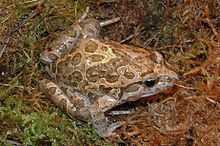Discoglossus pictus
| Mediterranean Painted Frog | |
|---|---|
 | |
| Scientific classification | |
| Kingdom: | Animalia |
| Phylum: | Chordata |
| Class: | Amphibia |
| Order: | Anura |
| Family: | Discoglossidae |
| Genus: | Discoglossus |
| Species: | D. pictus |
| Binomial name | |
| Discoglossus pictus Otth, 1837 | |
The Mediterranean Painted Frog, Discoglossus pictus, is a species of frog in the Discoglossidae family. It has three different subspecies, Discoglossus pictus pictus or Mediterranean Maltese Painted Frog, found at altitudes up to 1500m. In Malta this is the only native frog species. Discoglossus pictus scovazzi or Mediterranean Moroccan Painted Frog, occurring from sea level up to an elevation of 500m, although it is usually found below 100m. Discoglossus pictus scovazzi is found near water in open landscapes, in orchards and vineyards, as well as on campsites. They are also known to live and breed in slightly brackish water. Discoglossus pictus auritus or Mediterranean Spanish Painted Frog, in Europe, found in Spain,found in northern Africa in the province of Gerona.
As the common name implies, these frogs can have colorful markings. There are three pattern variations in this species: almost uniformly colored animals; animals with large dark spots with bright edges and animals with two dark brown longitudinal bands, one bright band along the back and two bright bands along the sides. The belly is whitish. The body is stout with a flat head that is wider than it is long. The dorsal glands are arranged in longitudinal patterns along the back, or can be absent. The pupil is shaped like an upside-down droplet. In the Moroccan subspecies, sexual maturity is attained in one year. Mating in North Morocco takes place from January to early November. Copulation, in which the male clasps the female in the lumbar region lasts about 2 hr. Copulation in the Spanish specimens lasts only 35 s to 2 min. Females lay a total of 500 to 1000 eggs in one night of copulation. The females copulate with various males and each copulation a small clump of about 20 to 50 eggs are laid. The ovum diameter is usually 1.0 to 1.5mm; the gelatinous envelope 3-7mm. The eggs have no common envelope and form a loose mass on the water surface or may sink to the bottom. Eggs usually hatch in 2–6 days. Upon hatching, tadpoles are about three mm in length. In one to three months, they grow to about 33 mm and metamorphose into froglets of 10 mm. In Sicily, many populations are associated with man-made water bodies such as stone-sided cisterns, irrigation pipes and canals in cultivated areas.
They appear to be endangered by the intensification of agriculture. However, populations that live along rivers, seasonal ponds and swamps seem to be less endangered. However populations from northeast of the Iberian Peninsula could be a threat to some native species of frogs, especially those with which they co-occur in the same aquatic habitats[2].In North Africa is a very abundant species, especially in the sub-humid northern regions, but its presence reaches pre-Saharan oasis[3].Populations of Discoglossus pictus pictus on Malta and Gozo are said to be threatened by a reduction of the ground-water levels.It was introduced several times on the island of Comino. Unfortunately the introduced species of Levant Water Frog (Pelophylax bedriagae)on the Maltese archipelago is a direct competition of this species. In order to be able to effectively protect this species, more data is needed about its ecology and biology. Discoglossus pictus seems to be associated with man-made water bodies, at least for part of its distribution.
References
- C.Michael Hogan. 2012. Discoglossus pictus Otth, 1837. ed. B.Zimkus. African Ampibians Lifedesk
- 2. Escoriza, D. & Boix, D.(2012). "Assessing thepotential impact of an alien species in a Mediterranean amphibian assemblage: a morphological and ecological approach". Hydrobiologia 680: 233-245.
- 3. Ben Hassine, J. & Nouira, S. (2012). "Répartition géographique et affinités écologiques des Amphibiens de Tunisie".Revue d’Écologie (Terre & Vie) 67: 437-457.
External links
- ArchéoZooThèque : Painted frog skeleton drawing : available in vector, image and PDF formats
SCIBERRAS, A & SCHEMBRI, P.J. (2004) Alien Frog At Ta`Sarraflu. Sunday times December 5 pgs. 78-79.
SCIBERRAS, A. & SCHEMBRI,P.J. (2006) Rana bedriagae. Herpetological review 37(1) pg. 102
SCIBERRAS, A. (2006) L-Istorja ta' L-Amfibji Fil-Gzejjer Maltin. L-Orizzont Ottubru 25(Ghalik pg viii)